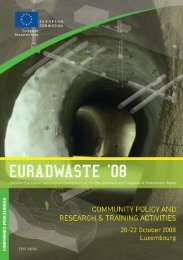EU industrial structure - EU Bookshop - Europa
EU industrial structure - EU Bookshop - Europa
EU industrial structure - EU Bookshop - Europa
Create successful ePaper yourself
Turn your PDF publications into a flip-book with our unique Google optimized e-Paper software.
<strong>EU</strong> <strong>industrial</strong> <strong>structure</strong> 2011 — Trends and Performance<br />
iii33 gross fixed capital formation<br />
Capital formation increases production capacity and can<br />
contribute to the competitiveness of firms and sectors<br />
by increasing labour productivity. Capital goods inject<br />
technology, innovation and intangibles (e.g. software)<br />
into the production process, and facilitate change and<br />
reorganisation. In addition, investment decisions are<br />
forward‑looking and, therefore, closely linked to the<br />
medium‑ and long‑term expectations of the sector. This<br />
section presents three indicators related to investment. The<br />
first is an indicator which relates investment to value added,<br />
the second refers to investment growth, and the third is<br />
a proxy for capital intensity based on investment flows.<br />
TAbLE III.4: <strong>EU</strong>-22 investment ratios in 2005-2009<br />
74<br />
The investment ratio is defined as the ratio of gross<br />
fixed capital formation (GFCF) to value added. 48 There is<br />
a relationship between the sectors where large companies<br />
dominate (Figure II.7) and the sectors with the largest<br />
investment ratios. Apart from the real estate and business<br />
activities sectors, those with the highest investment<br />
intensities are also the top sectors as far as large companies<br />
are concerned (above 250 employees): electricity, gas and<br />
water supply, transport and communication, mining and<br />
quarrying and refined petroleum. With the exception of<br />
a few sectors, the investment ratios have been quite stable<br />
over time. The crisis is evident as investment ratios drop in<br />
almost all sectors during 2009, cf. Table III.4.<br />
code sector 2005 2006 2007 2008 2009<br />
a Agriculture and forestry 0.33 0.34 0.34 0.40 0.35<br />
B Fishing 0.14 0.15 0.18 0.18 0.17<br />
c Mining and quarrying 0.24 0.31 0.36 0.35 0.31<br />
d Manufacturing 0.16 0.16 0.17 0.16 0.14<br />
da Food, drinks and tobacco 0.17 0.18 0.19 0.19 0.15<br />
dB Textiles and clothing 0.11 0.12 0.13 0.12 0.10<br />
dc Leather and footwear 0.09 0.10 0.10 0.10 0.08<br />
dd Wood and wood products 0.18 0.19 0.20 0.21 0.16<br />
dE Pulp, paper and publishing 0.16 0.16 0.16 0.14 0.12<br />
dF Refined petroleum 0.24 0.27 0.35 0.30 0.39<br />
dg Chemicals 0.15 0.16 0.18 0.18 0.16<br />
dh Rubber and plastics 0.16 0.16 0.18 0.17 0.12<br />
di Non‑metallic mineral products 0.20 0.21 0.22 0.24 0.24<br />
dJ Basic metals and metal products 0.14 0.15 0.16 0.16 0.16<br />
dK Machinery n.e.c. 0.11 0.11 0.11 0.12 0.11<br />
dl Electrical and optical equipment 0.13 0.13 0.14 0.12 0.11<br />
dm Transport equipment 0.22 0.20 0.20 0.19 0.19<br />
dn Other manufacturing 0.12 0.13 0.14 0.12 0.08<br />
E Electricity, gas and water supply 0.32 0.35 0.37 0.36 0.32<br />
F Construction 0.09 0.09 0.09 0.09 0.07<br />
>>><br />
48 The aggregate consists of BE, CZ, DK, DE, IE, ES, FR, IT, CY, LT, LU,<br />
MT, HU, NL, AT, PL, PT, SI, SK, FI, SE and UK. Netherlands is not<br />
included in the manufacturing sector DC: Textiles and Lithuania<br />
is not included in DF: Refined petroleum.
















